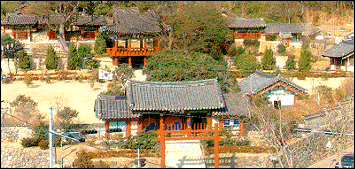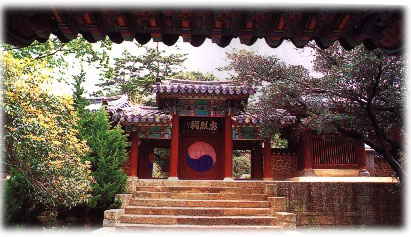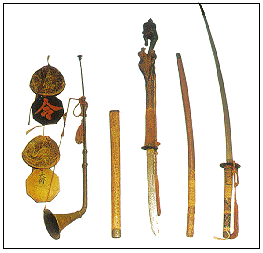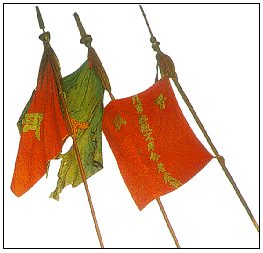Now, Chungyolsa is composed of 22 buildings such as shrines
and Dongseoje, Gyongchungje, Seongmudang, Plate House, Exhibition
Hall, Ganghanru in the precinct area of 8,172 §³. It also
includes the Ming Dynasty Palsapum (treasure no. 440), local tangible
cultural asset Chungyol Tombstone, local monument camellia,
and other movable cultural assets. Particularly in Chungyolsa,
events are specially held in the spring and fall, on the jungjong
day of Lunar February and August in memory of Admiral Lee, the soul
of the national defense, and all the soldiers under his command.
These are stolen military goods that
were sent by Emperor Shin of the Ming Dynasty and kept here. 2. Hodu Commanding Tablet : This is made of wood,
20.5 cm wide, 21 cm long, and 1.7 cm thick, with one side painted
black, and the word "command" is inscribed red color,
and the other side powdered and the word "commander" is
written. 3. Ghost sword 2 pieces : This is a sword with
a total length of 162 cm, the length of the blade is 90 cm, and
width 4.3 cm. The handle is made of bead wood with a dragon's head
carving and on top of it, a red sculptured ghost head is mounted.
4. Cham Sword : This is a sword, 162 cm long and 3.5 cm wide. The handle is made of wood, but wrapped with shark skin, painted red, and then wound with cowhide thread. The sheath is also made of wood, wrapped in cowhide, painted red, and then decorated with silver-plated iron. 5. War Banner 2 scrolls : This is a banner used to encourage soldiers to fight vigorously in battles. It is 60 cm wide. 70 cm long. The handle is 303 cm long and at the tip of the handle is a 24 cm long spear. It is made of indigo silk and in the center " Follow the command when faced with the enemy, or you will be killed" is written. On both the left and right sides, a patch bearing the statement "Challenge! At the tip of the banner, spear is fixed." is sewn. 6. Red Commanding Banner 2 scrolls : This is a banner, 60 cm wide, 70 cm long, with a handle 204 cm long, which was used to convey military commands. 7. Indigo Commanding Banner : This is of the same
type as the Red Commanding Banner, but the word "command"
made of red silk is patched on the indigo silk surface. 8. Curved Trumpet 2 pieces : This is a curved trumpet
130 cm long, with the mouth diameter of 19 cm. It is made of copper,
with its mouth spreading wide, 4 joints, and a red tassel hanging
down. It was so named because of the curved neck. |
|
 Chungyolsa
is the shrine where the mortuary tablet of Admiral Lee is enshrined.
It was built under the royal order in the 39th year of King
Seonjo (1606), 7 years after the end of the Imjin War, by Lee Unyong,
the 7th admiralty commander, in order to admire and commemorate
the Admiral's loyalty and brilliant exploits. After
that, in the 4th year of King Hyonjong, the king gave the name Chungyolsa,
for which the calligraphy was written by Sir Munjong, Song Jeongil.
In the 11th year of King Hyonjong, Choe Seok, the 51st admiralty
commander, added Kyongchungje to open a private school and educate
the local children. In the 44th year of King Sukjong (1718),
Kim Junggi, the 92nd admiralty commander, created Sungmudang and
selected 3 military officers and had them solicit money and cereals,
do office work and control.
Chungyolsa
is the shrine where the mortuary tablet of Admiral Lee is enshrined.
It was built under the royal order in the 39th year of King
Seonjo (1606), 7 years after the end of the Imjin War, by Lee Unyong,
the 7th admiralty commander, in order to admire and commemorate
the Admiral's loyalty and brilliant exploits. After
that, in the 4th year of King Hyonjong, the king gave the name Chungyolsa,
for which the calligraphy was written by Sir Munjong, Song Jeongil.
In the 11th year of King Hyonjong, Choe Seok, the 51st admiralty
commander, added Kyongchungje to open a private school and educate
the local children. In the 44th year of King Sukjong (1718),
Kim Junggi, the 92nd admiralty commander, created Sungmudang and
selected 3 military officers and had them solicit money and cereals,
do office work and control.  Also, he received Yondae-do (located in Sanyang
town, Tongyong-shi) as a land conferred by the king and secured
fields and paddies to preserve the shrine.
Also, he received Yondae-do (located in Sanyang
town, Tongyong-shi) as a land conferred by the king and secured
fields and paddies to preserve the shrine. 
